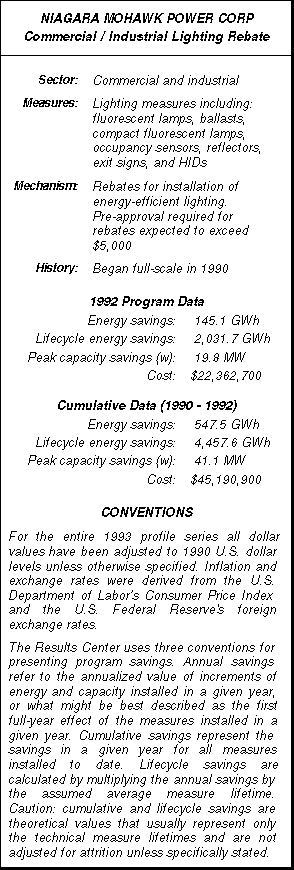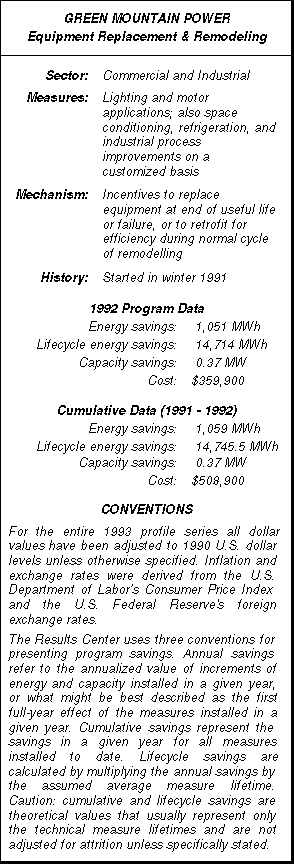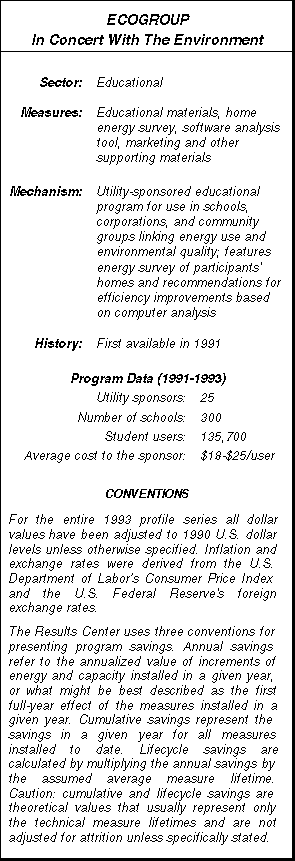EXECUTIVE SUMMARY
 In terms of energy savings, Niagara Mohawk’s Commercial and Industrial Lighting Rebate program is the largest program that has been profiled by The Results Center. Begun in 1989 as a pilot around Albany, New York, the program was quickly ramped up to encompass all of NMPC’s service territory. In 1990 the program achieved evaluated energy savings of 55 GWh, then grew to 117 GWH in 1991, before racking up an impressive 145 GWh in 1992.
In terms of energy savings, Niagara Mohawk’s Commercial and Industrial Lighting Rebate program is the largest program that has been profiled by The Results Center. Begun in 1989 as a pilot around Albany, New York, the program was quickly ramped up to encompass all of NMPC’s service territory. In 1990 the program achieved evaluated energy savings of 55 GWh, then grew to 117 GWH in 1991, before racking up an impressive 145 GWh in 1992.
One of the keys to the success of the C/I Lighting Rebate program has been the emphasis placed on both process and impact evaluations conducted for each year of the program. Through these evaluations, the program has evolved. For instance, rebate levels have been modified (mostly decreased over time), relative levels of rebates between new construction and retrofits have also been adjusted, and the list of eligible equipment has been changed to reflect both new technologies and technologies that are deemed to no longer require incentives. NMPC can tell its customers have been tracking program changes as well. In the last two weeks of 1992 NMPC received a surge of 1,000 rebate applications, signalling that its customers were well aware of the impending decreases in rebate levels for 1993!
Given the magnificent nature of the program -- over three million pieces of hardware have been installed as a result of the program’s three-year history -- the program has been influential in transforming the market for some energy-efficient technologies. In 1992 NMPC purposefully offered rebates for eight-foot, T8 fluorescent lamps, a technology that at the time was not yet commercially available but which had been cited as an important addition to the roster of energy-efficient technologies coming into the marketplace. A few months later the eight-foot, T8s were available for consumers in NMPC’s service territory, signalling the power of such a program to draw new, emerging technologies into a regional marketplace!
Finally, NMPC has reached approximately 7% of its eligible customers through the C&I Lighting Rebate program at a cost of $45.2 million. Of this total amount, fully 85%, or $38.4 million, has been spent on rebates and the remaining 15% or $6.8 million on administrative costs. Despite these enormous nominal costs and taking account of the fact that NMPC has effectively derated savings based on detailed impact evaluations, using a 5% real discount rate The Results Center calculates that the program has cost only 0.65, 1.65, and 1.56¢/kWh in 1990, 1991, and 1992, a remarkable achievement well worthy of attention and careful examination.
[CLICK HERE TO DOWNLOAD THE ENTIRE 22 PAGE PROFILE IN PDF FILE FORMAT]
This profile was produced by

 Green Mountain Power began its Equipment Replacement and Remodeling (ERAR) program at the end of 1991 in conjunction with the launch of seven other new DSM programs all developed within a collaborative process between the utility, its regulators, and interveners. The program’s replacement component is designed to allow customers to replace equipment at the end of its useful life with new energy efficient equipment at zero marginal cost. The remodeling component, which includes a technical assistance aspect, is specifically targeted at national accounts such as hotel and restaurant chains, to allow facility upgrades during periodic renovation cycles.
Green Mountain Power began its Equipment Replacement and Remodeling (ERAR) program at the end of 1991 in conjunction with the launch of seven other new DSM programs all developed within a collaborative process between the utility, its regulators, and interveners. The program’s replacement component is designed to allow customers to replace equipment at the end of its useful life with new energy efficient equipment at zero marginal cost. The remodeling component, which includes a technical assistance aspect, is specifically targeted at national accounts such as hotel and restaurant chains, to allow facility upgrades during periodic renovation cycles. The Federal government is the largest single user of energy in the United States. In 1991 the government used about 1.5 quadrillion BTUs of energy, equal to approximately 2% of total U.S. energy consumption. Since estimates of potential energy savings from federally-controlled buildings and facilities range from 25-40%, the U.S. Department of Energy developed the Federal Energy Management Program (FEMP) which was supported by an executive order which called for a 5% reduction in 1985 levels of federal energy use and a 10% reduction in 1995 levels of energy use by the year 2000.
The Federal government is the largest single user of energy in the United States. In 1991 the government used about 1.5 quadrillion BTUs of energy, equal to approximately 2% of total U.S. energy consumption. Since estimates of potential energy savings from federally-controlled buildings and facilities range from 25-40%, the U.S. Department of Energy developed the Federal Energy Management Program (FEMP) which was supported by an executive order which called for a 5% reduction in 1985 levels of federal energy use and a 10% reduction in 1995 levels of energy use by the year 2000. In Concert With The Environment® is an educational program that forges a link between energy use and the environment and has been primarily used for high school students. Developed by EcoGroup of Tempe, Arizona, the program is customized for each sponsor and is now being used by 25 utilities in 17 states for well over 130,000 students creating a win-win situation for sponsoring utilities and their customers.
In Concert With The Environment® is an educational program that forges a link between energy use and the environment and has been primarily used for high school students. Developed by EcoGroup of Tempe, Arizona, the program is customized for each sponsor and is now being used by 25 utilities in 17 states for well over 130,000 students creating a win-win situation for sponsoring utilities and their customers.